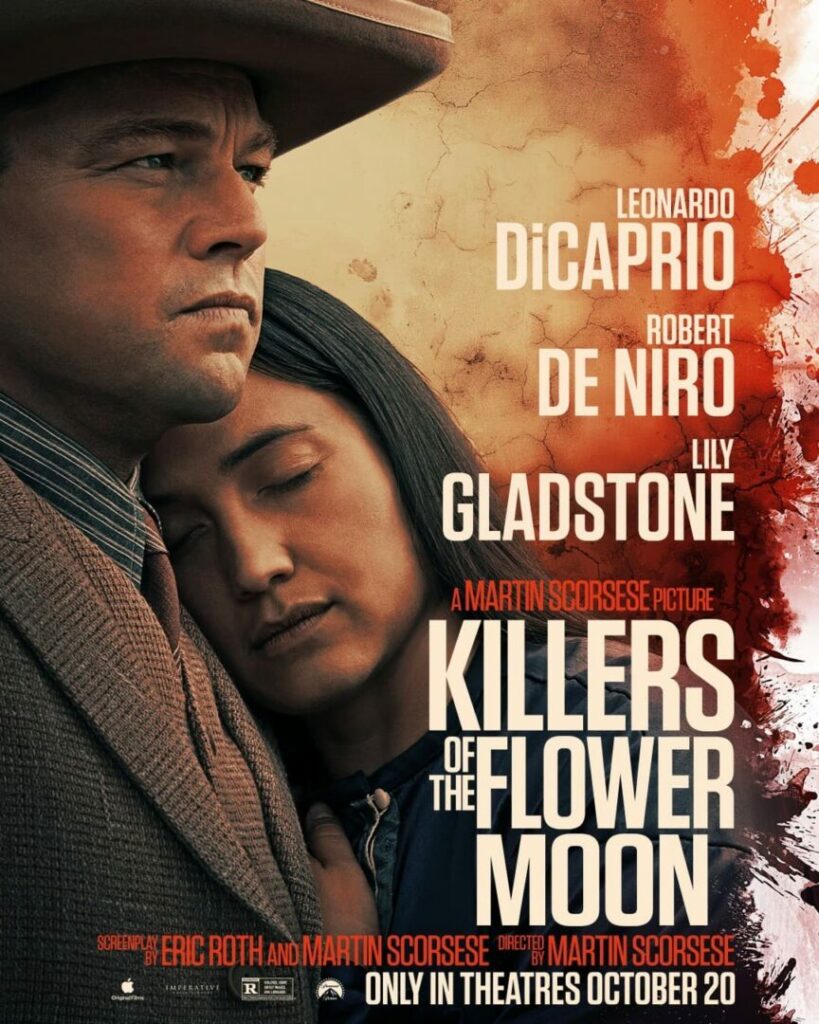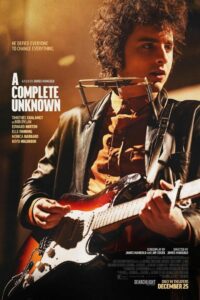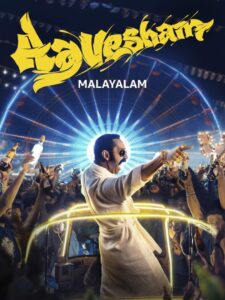One-line review: Oil makes the blood flow.
I have seen the film four times now. The first time was awe-inspiring, although confusing with so many characters. The second time was about savoring the experience of Maestro Scorsese conducting his A team, all peaking. The third time was to experience it again while it lasted in the cinemas. The fourth time, it was the nuances of Leonardo Di Caprio’s expressive face that stood out.
The movie’s journey to the big screen was tumultuous. Scorsese rewrote the script after working on it (with Eli Roth) for over two years. The early script was faithful to David Grann’s book and told the story from the perspective of Federal Investigator Tom White (to be played by Di Caprio). It was also the origin story of the FBI since Edgar Hoover sent him as a publicity exercise to investigate the spate of murders of members of the rich Osage Community. But Scorsese says the film began to feel like a police procedural, and Di Caprio (also a producer) asked him to rethink the story’s heart after a meeting with the Osage community. During the meeting, one of the Burkhardts’ (the focal Osage family in the film) grandchildren told them that his grandparents loved each other, although the husband Earnest was complicit in the killings of many of his wife Molly’s family.
Scorsese then rewrote the script with the love story at its center and Di Caprio now playing Earnest. Paramount was queasy about backing a movie with Di Caprio playing a weak and immoral character, a fear not unfounded since the New Yorker’s Anthony Lane expresses his frustration about watching a film centering around a weak man. This observation is interesting since we do not mind watching ruthless mafia dons. But Apple saw this as an opportunity to start their movie business, a handsome gamble since the movie is a critical success and a slow-burn box office success. Paramount thankfully held on to the distributing rights so the film could be shown on the big screen before moving to streaming. Imagine not being able to see the scene of the Osage community members dancing in the gushing oil fountain to Robbie Robertson’s pulsating beats on the big screen. It is exhilarating yet comes with a sense of foreboding.
The film begins by introducing the Osage Nation, a place with the highest per capita income in the world, thanks to their newfound oil. They are also big spenders, and soon, the hawks, aka white men, descend, becoming their fund managers, overpriced workers, and merchants charging them Osage prices (a photograph cost $40 then, Scorsese drives home this point cleverly by showing an overpriced yet blurred picture). Soon, a series of unsolved murders of the Osage begins.
In the meantime, Earnest Burkhardt (Di Caprio), a cook in the army, is returning after World War One to work for his Uncle William Hale (Robert Di Niro), a wealthy rancher and friend of the Osage. Earnest’s brother Byron (Scott Shepherd) also works for Hale. Hale is ruthless mercenary, trying to usurp as much money as possible from the Osage while his luck lasts. He puts Earnest to work as a cab driver. Earnest is often out all-night stealing to pay for his gambling addiction. Earnest is charming and soon has a regular passenger, Molly (Lily Gladstone), one of the four pure-blooded wealthy Osage sisters. Earnest and Molly fall in love, and Hale sees his big opportunity. The family is already sickly with diabetes, and he can hasten their demise with the help of some thugs and Earnest, who loves Molly but is under his uncle’s spell. Earnest also loves money, especially easy money.
Hale puts Earnest to work behind the scenes to orchestrate a web of deceit, botched murders, and successful murders, and soon, Molly is the only daughter alive. But Molly is diabetic, and her health is deteriorating rapidly under mysterious circumstances. She is determined to seek justice for her family and community before she dies. She goes to DC to meet President Hoover since the detective she hired went missing (thanks to Earnest and Hale). The most moving moment when I first watched the movie was the arrival of the Federal Investigator, Tom White (the always reliable Jesse Plemmons), because President Hoover, although cordial, barely pays any attention to Molly. It was heartwarming to note that he did listen and help.
The culprits are soon rounded up, and Earnest agrees to a plea deal to testify against Hale. But he loses courage when he faces Hale in court and turns hostile. The investigators rush a dying Molly to the hospital where she recovers enough to attend the court proceedings, her love for Earnest undiminished. A family tragedy leads to Earnest changing his mind, and justice is served. Just as the going gets heavy with legal arguments coupled with the beyond the three-hour mark, Scorsese gives you a brilliant grand finale: an epilogue in the form of a radio show about the Osage murders and the updates on what happened to the main characters. Scorsese also makes an appearance to give an update about Molly. You can only tip your hat at this unexpected, exuberant ending. When Spielberg asked him about this brilliant epilogue, Scorsese said it was to show that the Osage murders eventually became entertainment as a radio show. Scorsese appears as one of the voice actors to show he too was complicit in this.
The film reunites De Niro and Di Caprio after their 1993 film, This Boy’s Life, after which De Niro told Scorsese to watch out for this kid. Thirty years later, Di Caprio gets top billing, although Di Niro is still going strong. Ellen Lewis and Rene Haynes perfectly cast the movie. It was a long and laborious process starting in 2018, and they saw at least 2500 people just from the Indigenous people, casting newcomers like the scene-stealing Blackie (Tommy Schultz). Tantoo Cardinal as Molly’s feisty mother, and Cara Jada Myers as Anna Brown, Molly’s outspoken sister, particularly stand out. The film also has musicians like Sturgill Simpson and Pete Yorn playing roles, adding to the film’s freshness given that two Hollywood heavyweights are in it.
De Niro is superb; it is a testament to his acting prowess that although he plays the character Hale as pure evil, he still comes across as multi-dimensional. This is because Hale is just doing what needs to be done to protect his interests. Di Caprio has the toughest role since we do not know much about Earnest, except that he loves his wife but is under his uncle’s spell. His face was a palette of emotions, and just when I expected a scowling Leo to blink furiously, he stared; this is the great Di Caprio, after all. I hope he does something light next while his boyishness remains intact: the fleeting scene of a smiling Earnest joining a scuffle is a picture worth more than a thousand words.
But amidst all the evil and double-crossing, stands Molly, steady as a rock yet soft and feminine, played by the exquisite Lily Gladstone. Casting this unknown beautiful Native American actor, who also delivers, is the film’s biggest trump card. You long to see her poise as the film turns into a slugfest between the two scowling men. And like Di Caprio, we wish she had more scenes to smile. The only misstep in the film is the casting and acting of the Burkhardt kids. They appear only briefly but are so wooden, they stand out like sore thumbs in this otherwise flawless film. Scorsese is human, after all. Brendan Frazer received some flak for his over-the-top performance as Hale’s lawyer, but the Oscar winner adds to the film’s unpredictability.
The film’s heartbeat is its music with a pulse steadily beating in the background. This film was particularly meaningful to Robbie Roberston, Scorsese’s long-term music collaborator, given his native American roots (he grew up on a reservation); how befitting that this is his last film (he died before the movie’s release). Another frequent collaborator, cinematographer Rodrigo Prieto, talks about the importance of approaching the film with innocence and capturing the Osage rituals at the same time of the day they are held. And, of course, the behind-the-scenes star, Scorsese’s long-term friend and editor, Thelma Schoonmaker. One can only imagine the amount of footage she had to parse through to make the editing decisions, including leaving many scenes with the Osage language without subtitles. It is understandable why she is angry that some cinemas are editing her work with an intermission.
With all the new and exciting releases currently on, the mind tells me to use my time efficiently, but the heart longs to go back to the cocoon that will soon be gone. All signs point to a fifth-time watch.


